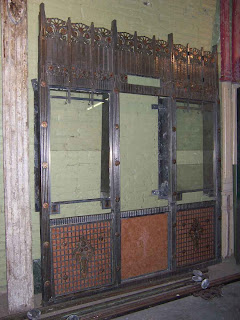 We finally got around to visiting Second Chance, one of the largest and most interesting architectural salvage stores located in Baltimore. I've been wanting to visit this non-profit organization after reading an interview by founder Mark Foster in 2005. The Philadelphia Civic Center had just been torn down to make room for UPenn's expanding medical campus. Built in 1931, the Convention Hall was a beautiful structure with Art Deco details. Among other things, it had a very Roman frieze running along its exterior. The structure had been abandoned for years with occasional graduation ceremonies taking place in its deteriorating halls. Back in the 1990s, it also served for concerts, and I vaguely remember a controversial shooting that took place after a rap event. This might have been the building's death blow. With the construction of a new Convention Center on 12th Street, the Civic Center on 34th Street became even less marketable for reuse. Preservationists tried to save the building without success.
We finally got around to visiting Second Chance, one of the largest and most interesting architectural salvage stores located in Baltimore. I've been wanting to visit this non-profit organization after reading an interview by founder Mark Foster in 2005. The Philadelphia Civic Center had just been torn down to make room for UPenn's expanding medical campus. Built in 1931, the Convention Hall was a beautiful structure with Art Deco details. Among other things, it had a very Roman frieze running along its exterior. The structure had been abandoned for years with occasional graduation ceremonies taking place in its deteriorating halls. Back in the 1990s, it also served for concerts, and I vaguely remember a controversial shooting that took place after a rap event. This might have been the building's death blow. With the construction of a new Convention Center on 12th Street, the Civic Center on 34th Street became even less marketable for reuse. Preservationists tried to save the building without success.A little before its demolition (see photos here), Second Chance came in and stripped all the historical detailing. Much of it has already been sold, but some is still in view at Second Chance's warehouse, like the ticket booth (photo above). With all the development happening in Philadelphia since the financial crash, I'm surprised that nobody has bought this spectacular installation and reused it in one of the many new lobbies. For those that can't visit Baltimore, fragments from the Civic Center can be seen here. Second Chance also has parts of The Wire stage set, like the interior of the mayor's office.
This is how Second Chance works. It charges 25% more than other demolition companies to tear down a structure and save its salvageable pieces, which it then sells in its four warehouses. In return, property owners get up to $250,000 in tax write-offs in addition to the moral joys of saving history. Most of the material in Second Chance is, actually, donated. The store also trains people in a variety of skills and certifies them with the ability to demolish historical structures without damaging the historical fabric. In short, Second Chance is more than just an inert operation. It recycles both history and physical resources in the depressed urban environment of Baltimore. The salesmen told us that Second Chance is actually moving (once again) from its current location. With all the discussion of sustainability, this is a noteworthy model.
Seeing the fragments of countless buildings was a thrilling experience and exercise in historical interpretation. It makes one think of earlier examples of architectural recycling in antiquity, the middle ages, and even the early modern period. Architectural salvage stores also have great potential for teaching history, archaeology and design. Unlike antique stores, they display utilitarian fragments that require imaginative skills as well as the understanding of how buildings are constructed. Next semester, I hope to include salvage visits in my architectural history class. Seeing a standing building, or even a museum interior installation is one thing, but seeing the guts of the building laid out on the floor is different. Although I cannot officially endorse such practices, dumpster diving and excursions to the city dump are highly educational endeavors. After all, the University of Arizona's archaeological program (the Tucson Garbage Project) is built on this very engagement with our own processes. See, William Rathje, Rubbish! The Archaeology of Garbage (1992).
Here are the architectural salvage stores I have visited so far. They embody different business models, clienteles, and artifacts. I hope to visit many more.
Second Chance, 1645 Warner St., Baltimore, MD 21230
ReStore, 3016 E. Thompson St., Philadelphia, PA 19134
Irreplacable Artifacts, 428 Main St., Middletown, CT 06457
Underground Salvage, 56 E. Main St, Brevard, NC 28712
Building Character, 342 N. Queen St., Lancaster, PA 17603
No comments:
Post a Comment